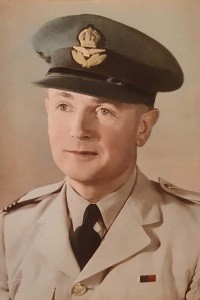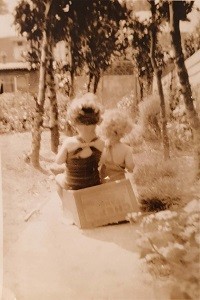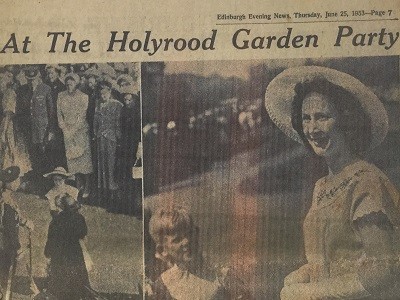Residents Remember
1. Resident: Joy Roberts 1934-
Joy writes:
“I am elderly but still have vivid memories of when the War broke out. On one occasion, my brother Peter and I were playing outside in a small go cart in the Plymouth street where we then lived. We were lucky that my brother saw a plane diving on us. He overturned our play-cart, so the bullets hit the cart and not us! My father was in the Royal Air Force and, leaving on a posting two days after the start of the War (but not know where he was going). In the event, he was sent to South Africa to train pilots to fly, only coming home some five years later, after the War was over.
I was born in 1934 and can recount quite a lot: my grandmother Lane lived in Gamble Road, North End. Both my parents were Portsmouth people. Mother Audrey would not let us be evacuated so for most of the War, we lived on a farm in the Wield near Four Marks in Hampshire. We also spent time with relatives in Portsmouth, aware of doodlebugs flying by the windows, then the noise cut out and we never knew if it was our turn to be bombed!
After the War, I also was very proud to attend the award ceremony with my Father when he received his MBE from the Queen at Holyrood House, awarded for services in South Africa.
Please read more about Joy’s father, Horace Tilzey MBE
2. Resident: Norman Wilson
Norman Wilson came to live in Rowlands Castle in 2015. He has offered photos and records of ration books as well as his father, Norman Trevor Hamilton Wilson’s photos and records. His father’s Royal Air Force career began in 1939, aged 23, retiring in January 1952. His father was rescued from the sinking of the liner RMS Lancastria, off St Nazaire. This emerges as one of the tragedies of World War II, being overloaded and leading to the possible loss of some 4,000 lives. (Lancastria was launched as the Tyrrhenia in 1920 on the Clyde, for a subsidiary of the Cunard Line, but renamed and refurbished as the Lancastria in 1924). She was requisitioned during the war assisting in the evacuation of Norway. Then assisting again in 1940, in the evacuation of British forces from France under Operation ‘Ariel’).
Having been rescued, Norman’s father was enlisted, posted as a Wireless Operator in RAF 98Squadron which, for several years, conducted long-range air patrols over the Atlantic in Sunderland Maritime Patrol Bombers, flying boats, from bases in Scotland and Iceland. One of the more successful encounters involved the sinking by depth-charges of U-Boats, enemy submarines. Please read the biography of his father Norman Hamilton Wilson.
3. Resident Alan Drinkwater 1939-
“I moved to Rowlands Castle in 1983 and am a founder member and trustee of the Rowlands Castle Heritage Centre, also editing this proposal to record events around World War II and VE Day. I was born in 1939, eight months before the War was precipitated, so was a young child – up to six years old. We lived in Harrow, Middlesex on the north-west outskirts of London. I remember that our semi-detached suburban house had a massive wooden air-raid shelter built in the living room. It was later replaced by a steel Morrison shelter (four angled steel corners, a flat steel roof, and meshed steel rods for side screens, slightly higher than a dining room table).
The three things that stick in my mind include the noise and blast of buzz bombs which occasionally flew over, cut out and exploded, shattering the glass in our windows. One time I was walking nearby outside when one cut out, followed by a silence… Secondly, I remember being evacuated with my mother to a farm near Kings Kerswell in Devonshire. I attended the local school, cared for by two local girls, where I never really settled down. This was partly because I was away ill for a few days and came back to a different desk in the small classroom (!) and did not like the potatoes served for school lunches! Thirdly, at home in Harrow, I remember with affection the two small chicken runs built by my father, where I spent hours talking to and feeding by hand several egg-laying hens!” Please read Albert Drinkwater’s auto-biography
4. In Memoriam
This section encompasses write-ups about two allied pilots who unfortunately crashed their fighter planes in Stansted Forest during the course of the War: Flying Officer Gerry Clermont, RCAF flying a Typhoon, and Flight Sergeant Sigurd Jenssen, RAFVR, a Norwegian Pilot, flying a Hurricane.
The site for a cross and interpretive plaque for Gerry Clermont was only recently relocated into a more prominent position in the Long Avenue extending from Stansted House. A service was conducted to which Gerry’s relatives from Canada and a representative from the Canadian Embassy in London had been invited. The relatives kindly loaned the medals that Gerry was awarded, for display in Stansted House. Residents from Stansted Estate and the Friends of Stansted Park as well as residents from Rowlands Castle attended. A Spitfire from Goodwood was invited for a brief fly-past. Ron Godwin (FOSP) has prepared a memorial booklet on Gerry Clermont.
Sigurd Jenssen is also recorded by a small plaque attached to a tree near where he crashed. Resident Brian Tomkinson has written a memorial notice.








